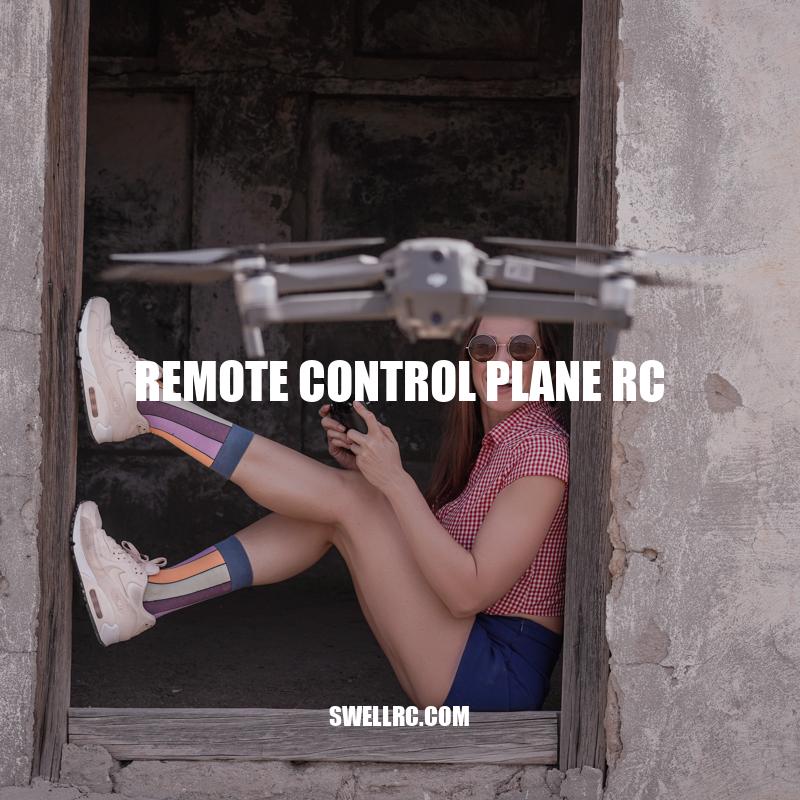Remote Control planes: A Beginner’s Guide to Flying High
Remote control planes are becoming an increasingly popular hobby due to their ability to provide thrilling aerial experiences and hands-on technological advancements. From electric to gas-powered and nitro planes, the remote control plane market has diversified to cater to different skill levels and interests. Whether you are a beginner or an experienced pilot, the different types of remote control planes offer unique experiences- from the speedy nitro planes to the cost-effective electric planes. Choosing the right remote control plane is crucial to fully enjoy this hobby, as selecting the wrong type can lead to frustration and a lack of enthusiasm for the activity. Proper setup, maintenance, and handling of the aircraft are also important for safe and optimal operation during flights.
As this hobby continues to grow, remote control planes enthusiasts have access to advanced features and techniques that were once solely reserved for trained pilots. From aerobatic maneuvers to gravity-defying stunts, the remote control plane hobby offers endless entertainment. However, beginners should start with simple take-off and landing techniques before advancing to more complex maneuvers. Mastering more advanced techniques requires a lot of practice, and a basic understanding of the aircraft’s mechanics and functions to prevent crashes and accidents. It is important to note that while flying remote control planes is a fun hobby, maintaining the aircraft is also crucial for its longevity and safe operation. Regular checkups, cleaning, and part replacement are necessary to ensure the aircraft is in optimal condition for each flight.
Types of Remote Control Planes
Remote control planes come in different types, each with unique features and performance capabilities. Here are some of the most popular types of remote control planes:
- Electric planes: These planes are the most popular choice for beginners due to their simple setup and maintenance. They are also quiet and environmentally friendly, making them a great option for indoor flights. Some popular brands of electric planes include HobbyZone, E-flite, and ParkZone.
- Gas-powered planes: These planes are more expensive and require more maintenance compared to electric planes. They offer better speed and performance, making them an excellent choice for experienced pilots. They’re generally louder than electric planes too. Some popular brands of gas-powered planes include Great Planes, Top Flite, and Seagull Models.
- Nitro planes: These planes run on a type of fuel called Nitro methane. They offer a great balance between electric and gas-powered planes, making them a great choice for intermediate pilots. Nitro planes are more complex compared to electric planes and require more maintenance compared to gas-powered planes. Popular brands of nitro planes include Phoenix Model, Seagull Models, and Hangar 9.
Choosing the right type of remote control plane depends on several factors including budget, skill level, and purpose. It’s advisable to research websites like HobbyKing, HorizonHobby, and MotionRC for more information on each type of remote control plane and the different brands available.
What types of RC planes are there?
There are several types of RC planes you can choose from depending on your preferences and skill level. Here are some of the most popular ones:
- Trainers – these are beginner-friendly planes that are designed to be stable and easy to fly. They are perfect for first-timers who are still learning the ropes of RC flying.
- Aerobatic planes – these are more advanced planes that are built for performing stunts and maneuvers in the air. They are more sensitive to control inputs, making them ideal for experienced flyers looking for a challenge.
- Scale planes – these are replicas of real-life planes that are created to look and fly like the real thing. They are often intricate in design and require more skill to fly accurately.
- Warbirds – these are scale models of military aircraft from WWII and other conflicts. They have a nostalgic appeal for many flyers, and are often challenging to fly due to their complex designs.
- Drones – while not technically planes, drones are a popular type of RC aircraft. They are equipped with cameras and other sensors, making them great for aerial photography and surveillance.
If you’re looking to buy an RC plane, there are many websites and products available. Some popular options include Tower Hobbies, Horizon Hobby, and Amazon. It’s important to do your research and choose a plane that suits your skill level and needs.
Choosing the Right Remote Control Plane
When choosing a remote control plane rc, it’s essential to consider your skill level, budget, and desired features. Here are some factors to take into account:
- Skill Level: If you’re a beginner, it’s best to start with an electric plane. Gas-powered and nitro planes have a steeper learning curve, and they require more skill and experience to fly properly.
- Budget: The cost of remote control planes varies depending on the type, brand, and size. Electric planes are generally more affordable compared to gas-powered and nitro planes. You can find some good-quality electric planes for less than $200. On the other hand, gas-powered and nitro planes can cost anywhere from $300 to $1000 or more.
- Desired Features: Different remote control planes offer different features, such as the ability to perform stunts or fly in first-person view. Some planes also come with additional accessories like landing gear, propellers, and cameras. Consider the features you want and choose a plane that meets your needs.
It’s also important to look at different remote control plane brands and manufacturers to ensure you choose a quality product. Some of the most popular brands in the market include Hobbyzone, HorizonHobby, E-flite, and Great Planes. In addition, online websites like Amazon and eBay offer a wide range of remote control planes, accessories, and replacement parts at affordable prices.
What is a good remote control plane?
A good remote control plane has the following features:
- A lightweight, durable construction
- Easy-to-use controls
- Long battery life
- Good range and stability
- Ability to perform tricks and stunts
Some popular remote control planes on the market are:
| Brand | Model | Price Range |
|---|---|---|
| Horizon Hobby | UMX Turbo Timber | $99-199 |
| Blade | Inductrix Switch | $59-79 |
| E-flite | HAVOC Xe | $249-299 |
For more information and reviews, websites such as Amazon, RC Universe, and Motion RC are helpful resources.
Setting Up a Remote Control Plane
Once you’ve chosen your remote control plane rc, it’s time to set it up and get it ready for flight. Here are some steps to follow:
- Read the manual: The first step in setting up your remote control plane is to read the user manual thoroughly. This will help you understand how to assemble the aircraft, charge the batteries, and calibrate the controller.
- Assemble the aircraft: Follow the instructions in the manual to assemble the aircraft, ensuring that all parts are secure and in the right place.
- Charge the batteries: Connect the battery to the charger and wait for it to charge fully before inserting it into the aircraft.
- Calibrate the controller: Turn on the transmitter and the aircraft, then calibrate the controller to ensure that it’s in sync with the aircraft.
- Test the aircraft: Before flying, it’s essential to test the aircraft to ensure that it’s working correctly. Test the motor, servos, and control surfaces to ensure that everything is functioning correctly.
- Find an open space: When flying your remote control plane, it’s essential to choose an open space free of obstacles and people. Schools, parks, and sports fields are great options for flying your plane.
- Stay safe: Make sure to follow all FAA guidelines when flying your remote control plane, such as staying below 400 feet and avoiding restricted airspace.
It’s also a good idea to invest in additional accessories, such as battery packs, propellers, and landing gear. Many online retailers like Amazon and HobbyKing offer a wide range of remote control plane accessories and replacement parts at reasonable prices.
How do you fly a remote control plane?
Flying a remote control plane can be a fun and exhilarating experience. Here are the basic steps to get started:
- Choose an open space with no people or buildings around.
- Check the batteries on both the remote control and the plane.
- Turn on the remote control first, then turn on the plane.
- Hold the remote control level and gently push the throttle forward to make the plane take off.
- Use the joysticks to control the plane’s direction, altitude, and speed.
- Practice flying in different weather conditions and locations to improve your skills.
It’s important to note that different types of planes may have unique controls and features, so it’s important to read the manual before flying. There are also numerous online resources available for remote control plane enthusiasts, such as RCGroups.com or Horizon Hobby’s website. These sites offer a wealth of information on how to fly remote control planes, as well as product reviews and community forums.
Advanced Remote Control Plane Techniques
Remote control planes offer a variety of impressive aerobatic maneuvers and stunts. Here are some skills to master:
- Loops: A loop is a basic aerobatic maneuver where the plane performs a complete 360-degree circle in the air. To perform a loop, the pilot must start by gaining altitude and then gradually pitching the aircraft into a nose-down attitude.
- Rolls: A roll is a maneuver where the plane rotates around its longitudinal axis while maintaining its altitude. Pilots can perform different types of rolls, such as slow rolls, snap rolls, and barrel rolls.
- Inverted flight: Inverted flight is a maneuver where the plane flies upside down. Pilots must maintain a steady throttle and adjust the control surfaces to keep the plane in the air.
- Knife-edge: A knife-edge maneuver is performed when the plane flies vertically, perpendicular to the ground, and at an angle. This maneuver requires precise control of the ailerons and rudder to maintain the correct position and direction.
- Stalls: A stall is a maneuver where the plane loses airflow over the wings and falls out of the sky. Stalls can be intentional or unintentional but are an essential part of learning how to fly remote control planes correctly.
Mastering these more advanced techniques requires skill and practice. Fortunately, there are several online resources available to help remote control plane enthusiasts hone their skills. Websites like RC Groups and Flite Test offer useful tips, tutorials, and forums where pilots can share their experiences and learn from one another.
Additionally, investing in a flight simulator like RealFlight can help you practice your remote control plane skills without risking damage to your aircraft. Flight simulators can be connected to your controller, allowing the pilot to fly a simulated plane using the same controls as the real aircraft.
There are several flight simulators available on the market today, ranging from free to pricey. Some of the most popular ones include:
| Product | Price | Description |
|---|---|---|
| RC Flight Simulator | $99 – $159 | A high-quality flight simulator that comes with a transmitter or can be connected to your remote control transmitter. Features include realistic physics, 3D landscapes, and over 140 aircraft to choose from. |
| AeroFly Professional Deluxe | $39.99 – $59.99 | A popular flight simulator offering high-quality graphics, realistic physics, and an easy-to-use interface. Includes over 200 aircraft and a wide range of landscapes to fly in. |
| ClearView RC Flight Simulator | $39.99 | ClearView RC Flight Simulator offers excellent physics and flight modeling, training modes for beginners, and the ability to use your remote control transmitter. The software features over 50 aircraft to choose from and a range of real-life landscapes to fly in. |
What are remote control airplanes used for?
Remote control airplanes, also known as RC airplanes, are primarily used for recreational purposes by hobbyists. They allow individuals to experience the thrill of piloting a plane without the risk of personal injury. Additionally, RC airplanes are used by enthusiasts for competitions, aerial photography, and even scientific research.
Several online retailers, such as HobbyKing, offer a wide variety of RC airplanes for purchase. These range from beginner models to advanced planes for experienced pilots. Additionally, websites such as RCGroups and RC Universe offer forums for individuals to connect with other RC airplane enthusiasts, share information, and discuss the latest trends in the hobby.
Overall, remote control airplanes are a fun and exciting pastime for those interested in aviation and technology.
Maintaining a Remote Control Plane
Proper maintenance is essential for the safe and efficient operation of your remote control plane (RC). Here are a few tips to help you keep your plane in top shape:
- Clean after each flight: After flying, wipe down your aircraft to remove any dirt or debris that may have accumulated. Use a soft cloth to avoid scratching the surface of the plane.
- Inspect before each flight: It is important to inspect your aircraft carefully before each flight to ensure that all parts are secure and in good condition. Look for any cracks, loose parts, or signs of wear.
- Replace damaged parts: If you notice any damage or wear and tear during your inspection, replace the damaged part as soon as possible. Broken or worn-out parts can affect the stability and safety of your aircraft.
- Charge batteries correctly: Always follow the manufacturer’s instructions when charging your remote control plane’s batteries. Overcharging or undercharging can lead to battery failure, which can damage your aircraft.
- Store properly: When your plane is not in use, store it in a dry and temperature-controlled environment to prevent damage from moisture and extreme temperatures.
In addition to these general tips, it is recommended that you follow the manufacturer’s guidelines for maintenance and upkeep. Each remote control plane model may have specific needs and requirements that are unique to that aircraft.
For more specific information on maintaining your remote control plane, you can consult online resources such as RC Groups or the manufacturer’s website. These resources can provide advice on troubleshooting common problems, finding replacement parts, and locating authorized repair centers.
Moreover, investing in a good quality remote control plane can increase its lifespan and reduce maintenance needs. Some of the most reliable brands in the market include DJI, HobbyZone, and E-flite. Conducting thorough research when considering buying a remote control plane can save you more significant expenses and time in the long run.
By following proper maintenance practices, you can ensure that your remote control plane remains safe, efficient, and functional for years to come.
How do you balance a remote control airplane?
To balance a remote control airplane, follow these basic steps:
1. Check the center of gravity (CG) of the aircraft by ensuring that it is at the recommended point as mentioned in the manual.
2. Adjust the CG as necessary by adding or removing weights from the nose or tail.
3. Make any necessary adjustments to the control surfaces (ailerons, elevator, and rudder) to ensure the plane flies straight and level.
Some resources that may be helpful for balancing remote control airplanes are:
| Website | Description |
|---|---|
| Flite Test | A popular website and YouTube channel dedicated to remote control aircraft with instructional videos and forums. |
| Horizon Hobby | An online retailer that sells remote control planes, parts, and accessories with helpful articles and guides. |
Additionally, there are some products that can assist with balancing remote control airplanes:
- Digital Scale – Used for measuring the weight of the plane
- Double-sided adhesive tape – Used for attaching weights to the plane
- Super Glue – Used for securing weights in place
Conclusion
Remote control planes are a fun and engaging hobby for people of all ages and skill levels. With a wide range of options available in the market, there is a remote control plane for everyone, from beginners to seasoned pilots. By taking the time to understand the various types of aircraft, proper setup practices, and maintenance techniques, you can ensure a safe and enjoyable flying experience.
As with any other hobby, remote control planes require time, effort, and dedication. However, the reward of being able to control an aircraft and perform stunning acrobatic maneuvers in the air more than makes up for the effort put in. Whether your interest lies in casual flying or competitive racing, remote control planes continue to be one of the most exciting and passionate hobbies.
In conclusion, if you’re looking for an exciting and engaging hobby, remote control planes are a great option. With so many options available, it’s never been easier to get started in the world of remote control planes. Remember to take the time to learn and practice your skills to ensure an enjoyable and safe flying experience. Happy flying!



